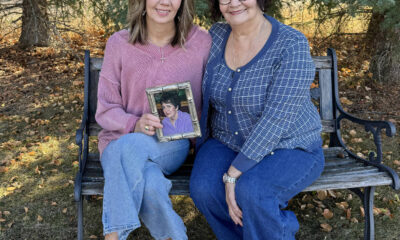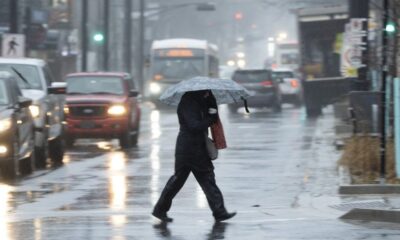Entertainment
Halloween’s Dark Side: Unpacking Fear Beyond the Costumes

The arrival of Halloween on October 31 often evokes a sense of excitement, but for some, it brings forth deeper fears that linger beyond the costumes and festivities. In a recent reflection by writer Alex Manley, the complexities of Halloween reveal an unsettling truth: for many, including those in the LGBTQ community, the day can be a source of anxiety rather than joy.
Manley recounts their personal experience with Halloween, noting a marked shift from childhood excitement to adult apprehension. As a young person, they found themselves increasingly uncomfortable with the holiday’s themes of fear and transformation. While others relished the thrill of dressing up and embracing the spooky season, Manley grappled with a profound unease, particularly around the concept of costumes and the power dynamics they represent.
Costumes and Identity
The act of wearing a costume on Halloween is often seen as a playful exploration of identity. Manley reflects on how costumes allow individuals to step outside their usual selves, tapping into new personas that can be liberating. Yet, for them, this transformation was daunting. The idea of people donning masks and becoming someone else suggested an erosion of trust, a moment when societal norms fell away, ushering in a sense of chaos.
This discomfort was compounded by the expectations of the LGBTQ community, where Halloween celebrations often emphasize elaborate costumes and creativity. Manley candidly expresses disdain for the pressure to conform to these social norms, feeling that failing to participate in the festivities marked them as dull or uninteresting. The pressure to fit in with a community of outcasts, while simultaneously feeling excluded, created a sense of isolation that deepened over the years.
The memories of past Halloweens linger, particularly a harrowing encounter with bullying that left a lasting impact. At around eleven or twelve years old, Manley experienced an unsettling interaction with older boys that escalated quickly. This moment, steeped in fear and humiliation, solidified their aversion to Halloween, as it became associated with danger and unpredictability.
Complexities of Queerness and Fear
Manley’s reflections highlight broader themes of queerness, neurodivergence, and the struggle for acceptance. They articulate a feeling of being caught between identities, grappling with anxiety and the expectations of both the mainstream and queer cultures. The fear associated with Halloween, for Manley, extends beyond costumes; it embodies a fear of male aggression and unpredictability in societal interactions.
The writer’s desire to withdraw from Halloween celebrations illustrates a significant aspect of their journey. Rather than embracing the chaos of the holiday, they found solace in solitude, often opting to stay home rather than engage in social festivities that felt overwhelming. This choice, while protective, also underscored a sense of being an outsider.
Manley’s experiences resonate with many who feel alienated during celebratory times. They articulate a struggle that is not unique to Halloween but reflects a broader challenge faced by those who navigate the intersections of identity, societal expectations, and personal comfort. The discomfort with Halloween serves as a microcosm for the larger societal dynamics at play, revealing the complexities of belonging and acceptance.
As Halloween approaches, the reflections of individuals like Alex Manley prompt a reconsideration of the holiday’s impact. While some may celebrate with enthusiasm, it is crucial to acknowledge that for others, this season may evoke feelings of fear and exclusion. Understanding these perspectives can foster a more inclusive environment where all experiences are validated, paving the way for a celebration that emphasizes safety and acceptance over fear and isolation.
-

 World4 months ago
World4 months agoScientists Unearth Ancient Antarctic Ice to Unlock Climate Secrets
-

 Entertainment4 months ago
Entertainment4 months agoTrump and McCormick to Announce $70 Billion Energy Investments
-

 Lifestyle4 months ago
Lifestyle4 months agoTransLink Launches Food Truck Program to Boost Revenue in Vancouver
-

 Science4 months ago
Science4 months agoFour Astronauts Return to Earth After International Space Station Mission
-

 Technology2 months ago
Technology2 months agoApple Notes Enhances Functionality with Markdown Support in macOS 26
-

 Top Stories3 weeks ago
Top Stories3 weeks agoUrgent Update: Fatal Crash on Highway 99 Claims Life of Pitt Meadows Man
-

 Sports4 months ago
Sports4 months agoSearch Underway for Missing Hunter Amid Hokkaido Bear Emergency
-

 Politics3 months ago
Politics3 months agoUkrainian Tennis Star Elina Svitolina Faces Death Threats Online
-

 Technology4 months ago
Technology4 months agoFrosthaven Launches Early Access on July 31, 2025
-

 Politics4 months ago
Politics4 months agoCarney Engages First Nations Leaders at Development Law Summit
-

 Entertainment4 months ago
Entertainment4 months agoCalgary Theatre Troupe Revives Magic at Winnipeg Fringe Festival
-

 Top Stories1 week ago
Top Stories1 week agoFamily Remembers Beverley Rowbotham 25 Years After Murder





















